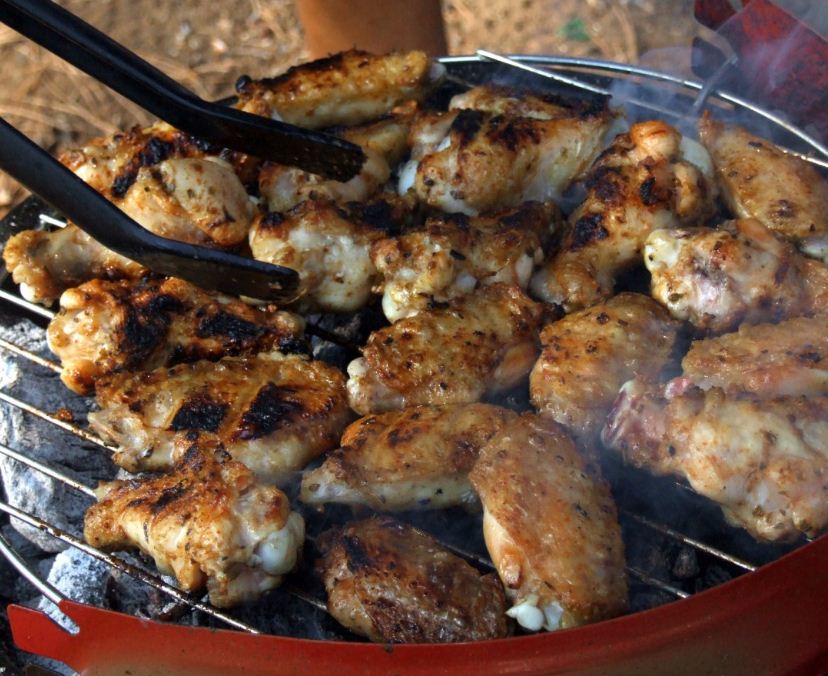
As the meat reaches the end of its cooking time, check the meat’s interior temperature with your instant-read thermometer. The optimum internal temperature for smoked meat is usually a good deal higher than well done.
|
Food
|
Time
|
Temperature
|
||
|
Chicken breast (1 lb)
|
1– 2 hours
|
160°F
|
||
|
Chicken, whole (3 lbs)
|
3–4 hours
|
160°F
|
||
|
Fish fillet (0.5–1 lb)
|
1–2 hours
|
140–155°F
|
||
|
Fish, whole (4–6 lbs)
|
2–3 hours
|
140–155°F
|
||
|
Rack of spare ribs (4–6 lbs)
|
5–7 hours
|
Until the meat pulls off the bone about 3/4 of an inch
|
||
|
Pork shoulder/butt (5–7 lbs)
|
6–8 hours
|
195–200°F
|
||
|
Brisket (3–4 lbs)
|
6–8 hours
|
185–190°F
|
||
|
Brisket (6–8 lbs)
|
10–12 hours
|
185–190ºF
|
Finishing Sauce
Some barbecue cooks also like to add a final finishing sauce to their barbecued meats. There are two basic types of barbecue sauce: vinegar-based and tomato-based.
Vinegar-Based Barbecue Sauce
Vinegar-based barbecue sauce is usually used with pork shoulder and is most often applied after the meat has been cooked and “pulled.” Making a vinegar-based barbecue sauce is easy. Just combine:
- 1 cup white vinegar
- 1 cup cider vinegar
- 1 Tbsp sugar
- 1 Tbsp crushed red pepper flakes
- 1 Tbsp Tabasco sauce
- Salt and pepper to taste
Tomato-Based Barbecue Sauce
Tomato-based barbecue sauce is used with all types of meat and can be applied to fully cooked meat or when 30–60 minutes of cooking time remain. Try one of the many tomato-based sauces on the market, or make your own.
- 4 large onions, chopped
- 3 tablespoons vegetable oil
- 1 28-oz can tomato puree
- 2 28-oz cans tomatoes
- 2 1/2 cups white vinegar
- 4 Tbsp dark brown sugar
- 4 Tbsp sugar
- 2 Tbsp salt
- 2 Tbsp ground black pepper
- 2 Tbsp paprika
- 2 Tbsp chili powder
- 4 Tbsp molasses
- 1 cup orange juice
- 2 Tbsp liquid smoke
- 8 Tbsp Dijon-style mustard
Sauté the onions in a large, heavy-bottomed saucepan with the vegetable oil for 8–10 minutes until golden brown. Add all the remaining ingredients, bring to a boil, and reduce heat to a simmer. Cook the sauce uncovered on very low heat for 2–3 hours, stirring frequently. Let the sauce cool for 20 minutes, then puree it in small batches in a food processor or blender.
Rest the Meat
Once removed from the smoker or grill, pork shoulder and brisket must “rest” before being served, to allow their juices to distribute. To rest the meat, cover loosely in tin foil and let it sit on a platter for 20–30 minutes. Smaller cuts of meat, such as ribs or chicken breasts, can be served immediately.
Cut the Meat
Cut barbecued chicken breast and fish as you normally would. Other barbecued meats require special techniques:
- Pork shoulder: Pork shoulder is usually served chopped or “pulled” into shreds. You can pull the pork either with your fingers or a fork. Properly smoked pork shoulder should practically fall apart when you pull at it.
- Brisket: Brisket must be sliced against the grain to prevent slices from being too tough. If you look closely at the meat’s surface, you’ll see lines or grains moving in one direction. Angle your knife perpendicular to these lines when slicing.
- Ribs: To cut ribs, use a use a thin, sharp knife to slice between rib bones. You can cut ribs into individual pieces or into groups.

